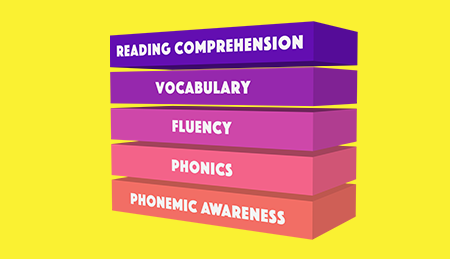1. Phonemic Awareness:
The ability to identify and manipulate the individual sounds (phonemes) that make up spoken words.
This is the first skill that children must master when learning how to read because it helps them to “hear” and “see” the connections between sounds and letters. It is also one of the most important factors in determining a child’s future reading success.
Phonemic awareness can be built through exercises that ask children to identify the first phoneme in a word, or rhyming activities that help children understand that words such as ‘cat’, ‘bat’, and ‘hat’ differ only in their first phoneme. It is also built through teaching children to blend and segment individual sounds in spoken words, for example by putting together ‘c’-‘a’-‘t’ to make ‘cat’ (blending) and breaking down ‘cat’ into ‘c’- ‘a’-‘t’ (segmenting).
2. Phonics
The process of systematically mapping phonemes (speech sounds) onto graphemes (letters and letter combinations)
.Through systematic synthetic phonics instruction, children learn the sounds that different graphemes make in a structured way, progressing from the most common ones to rarer ones. For example, f, ff, ph, and gh all make the sound /f/, but f and ff are more common than the others. Children also learn the different ways in which a sound can be spelled, for example, play and make have the same vowel sound written using two different graphemes. Phonics instruction is critical to early brain development.
3. Vocabulary
The words readers must know in order to understand what they read.
Children become better readers when they can quickly connect the words they know already to the words they see in a text. This means that a strong oral vocabulary is critical to becoming a good reader. It also means that teaching children relevant words that they are going to encounter in school and in books is crucial. In order to learn new vocabulary effectively, children need to encounter words within a relevant context.
Context helps children better understand what each word means, how it relates to the world around them, and how it is used. Building context around a new word helps children better retain this word in memory.
4. Fluency
The ability to read accurately, rapidly, and with expression.
A fluent reader moves through a text at a fluid pace, while simultaneously feeling and comprehending the meaning of the text. Teachers typically measure fluency through oral reading. But good readers also read with accuracy and expression when they read silently or “in their heads.” Readers who lack fluency are often still struggling with decoding. Lack of fluency may impact your child’s reading progression at school. You can work on this skill by reading aloud with expression for 10-15 minutes a day.
5. Comprehension
The ability to understand the meaning of a text.
This relates to why we read - to enjoy stories and learn new things. Reading comprehension draws upon all the other building blocks of reading, especially fluency and vocabulary, but it also requires reasoning skills in order to draw links between what we read and our background knowledge.
Sources for further reading:
Download our research overview on the Science of Reading.
Download our Deep Dive into Phonics to learn more about phonemic awareness and phonics.



























Comment
Leave a comment